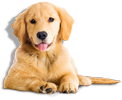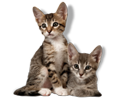losing weight and getting in shape cannot only add years to your pet’s life, but they also make those extra years
more enjoyable.
Helping your cuddly canine shed a few pounds may be easier than you think. It simply requires understanding the importance of weight loss and fitness, paying attention to detail, and seeking assistance from your veterinary team.
Why a healthy weight is important for your pet
If a dog is just five pounds over its ideal weight and if a cat is two pounds above its ideal weight, they are at risk for developing some serious medical conditions. When a pet is overweight or obese, it’s not a question of if it will develop a related illness, but rather how many and how soon. Some of the common disorders associated with excess weight include:
- Type 2 diabetes
- Heart disease
- Osteoarthritis
- Chronic inflammation
- High blood pressure
- Respirator
- Kidney disease
- Many forms of cancer

It is expected that overweight and obese dogs will have shorter lives than their fitter counterparts. Heavy dogs and cats tend to be less energetic and playful. It’s common to think pets that lie around are just lazy, making it easy to overlook the lethargy that results from being overweight or obese.

Weight Loss For Dogs
It is important that your dog understands you have places to go and that this is different than your usual casual walk. If they sit or refuse to walk, you may have to return home, crate them or put them in a quiet space without your attention and try again another time. We have yet to encounter a dog that didn’t take readily to brisk walking.
- Move the food bowl upstairs/downstairs and rotate it so that the dog always has to walk to get to its food bowl. Dogs are smart, and if the food bowl moves upstairs, they’ll start relocating upstairs, too.
- Move the food bowl as far away from your dog’s favorite haunts as possible. Again, many dogs will sleep and lay near the food bowl so they don’t have to go far when the eatin’ urge hits!
- Use toys, balls, laser pointers, squeaky toys, anything that your dog finds interesting to chase. Try to engage your dog for at least ten to fifteen minutes twice a day. There are numerous toys that move and squeak that may also be interesting to your dog. Experiment and understand that what is exciting today may be boring tomorrow.
- What about the dog that wakes you at four in the morning to be fed or the dog that stares at you during dinner or television time until you give in and feed them? Our dogs have trained us well and know exactly which buttons to press when it comes to getting their way. Here are some tips for handling the pleading pup:
- Do not use a self-feeder. Auto-feeders are unlimited candy machines to a dog.
- Pet or play with your dog when it begs for food. Dogs substitute food for affection so flip the equation and you may find that playtime displaces chowtime.
- Walk your dog when it begs. The distraction may be just enough to make it forget its desire for food.
- Feed small meals frequently – especially for those dogs that like to wake you up in the wee hours begging for more goodies – divide the total volume or calories into 4-6 smaller meals – whatever you do, don’t feed extra food.
- When the bowl is empty and your dog is pleading, add a few kibbles to the bowl. By a few, try ten or fifteen – not a handful.
- Give vegetables such as baby carrots, broccoli, zucchini, celery and asparagus. Dogs love crunchy treats so make it a healthy – and low-calorie – choice.
Weight Loss for Cats
- Play “Find the Food” move the food bowl upstairs or downstairs and rotate it so that the cat always has to walk to get to its food bowl. Cats are smart, and if the food bowl moves upstairs, they’ll start relocating upstairs, too.
- Move the food bowl as far away from your cat’s favorite haunts as possible. Again, many cats will sleep and lay near the food bowl so they don’t have to go far when the eatin’ urge hits!
- Use feather toys, flashlights, paper bags or balls, anything that your cat finds interesting to chase. Try to engage your cat for ten minutes twice a day. You can do this while you eat, watch television or even read. There are numerous toys that move and squeak that may also be interesting to your cat. Experiment and understand that what is exciting today may be boring tomorrow.
- Do not use a self-feeder. These are unlimited candy machines.
- Pet or play with your cat when it begs for food. Many cats substitute food for affection so flip the equation and you may find that playtime displaces chowtime.
- Feed small meals frequently – especially give a last feeding for those cats that like to wake you up in the wee hours begging for more goodies – divide the total volume or calories into four to six smaller meals – whatever you do, don’t feed extra food
- When the bowl is empty and your cat is pleading, add a few kibbles to the bowl. By a few, try ten or fifteen – not a handful.
- Offer fresh water instead of food. Many cats love fresh water so when they are eyeing the empty food bowl, fill up the water bowl instead.
- Feed separately – this is the ideal solution for multi-cat households. Feed the cat diagnosed with obesity its diet in one room while feeding the other cat its food elsewhere. After a prescribed time, generally 15 to 30 minutes, pick the food up until the next feeding.
- Feed the normal weight cat on an elevated surface where the obese cat can’t go.
- Do not leave food out while you’re away. In this scenario, you can’t be sure who ate what and the smart money is on the cat with obesity.



